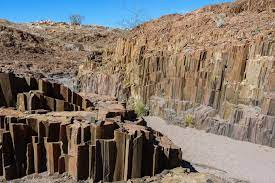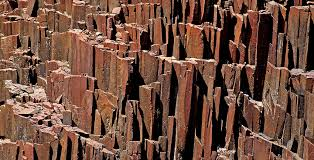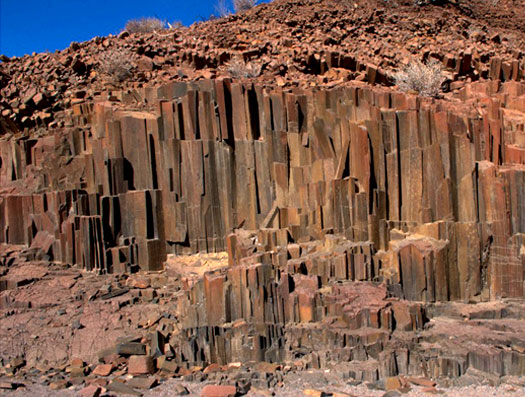The so-called Organ Pipes are situated near the small inselberg of Burnt Mountain, west of the town of Khorixas in Namibia. They are a rock formation that comprises a group of columnar basalts which resemble organ pipes. The Organ Pipes were formed about 150 million years ago as the result of the intrusion of liquid lava into a slate rock formation, which was exposed over time by erosion.
The beautiful organ pipes are a fascinating geological formation located near Twyfelfontein. Strikingly rich rusty colors are portrayed in long columns resembling those of a church organ, some rising up to 5m high. Thought to be the result of the Gondwanaland breakup, fractures and cracks were formed as the dolomite columns cooled through the process of columnar jointing approximately 120 million years ago.
Just a short walk from the Organ Pipes is a small inselberg named the Burnt Mountain, proclaimed a national monument on 15 September 1956. The reason for its name is best evident in the early mornings and late evenings when the rays of the sun seem to set the mountain ablaze. Rich red colors mixed with shades of black and purple are quite strikingly caused by Manganese coated clay molecules. During the day, however, the inselberg is just a normal black color as if the morning fire has burnt it to ashes.
The barren mountain "Verbrandeberg", meaning “Burnt Mountain”, was proclaimed a national monument in 1956. The unique display of colours on its slopes and surfaces during morning and evening hours was a highlight in an otherwise arid landscape around Twyfelfontein.
The Burnt Mountain, a sheet of dolerite, an igneous rock associated with volcanic activity that occurred in the area some 120 million years ago (probably associated with the Cretaceous Etendeka volcanism), intruded black carbonaceous shale of the Permian Prince Albert Formation of the Karoo sequence. The high temperature of the dolerite (about 1,0000C) baked the shale.
During the contact metamorphism that was caused by the intrusion, volatile organic components were driven off from the shale, leaving a charred black, clinker like burnt mass from which the mountain got its name.






No comments:
Post a Comment